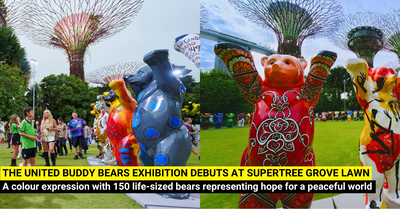Through over 80 fukusa, kimonos, and related textiles, Fukusa: Japanese Gift Covers from the Chris Hall Collection explores craft, trade and exchange, and the act of gifting across cultures.

Venue: Peranakan Museum
Dates: 19 April to 25 August 2024
Admission: $6 for Singaporeans and Permanent Residents; $16 for Foreigners
The act of gifting is deeply ingrained and takes many forms across histories and cultures. In Japan, the practice of formally presenting gifts with silk covers called fukusa began in the Edo period (1603–1868). These covers were draped or folded over gifts for a variety of occasions, from seasonal festivities to important personal events, and are some of the finest examples of Japanese textile artistry.
An Exhibition of over 80 Fukusa

Fukusa: Japanese Gift Covers from the Chris Hall Collection celebrates a major gift of Japanese art from the renowned collector Chris Hall. With over 80 fukusa, kimonos, and related textiles displayed, the exhibition explores craft; trade and exchange between Japan, China, and the West; and the act of gifting across cultures, as seen through a presentation of Peranakan textiles from the National Collection. Visitors are invited to draw connections between gift customs of the past and present through an interactive digital programme, and to participate in hands-on workshops, performances, and tours.
Get Introduced To Fukusa

The custom of covering gifts with fukusa emerged in the Edo period (1603–1868) and was initially used in ceremonies by the ruling warrior class (samurai) and nobility. By the early 19th century, well-to-do merchants and other wealthier members of Japanese society had also adopted this practice.
As with fashion, fukusa asserted the taste, wealth, and identity of their owners, and sometimes mirrored designs from stylish garments. The second section of the exhibition charts the similarities between fukusa and fashion through designs, materials, and techniques, and examines how the politics of dress intersected with fukusa design in the late Edo period.

Fukusa can be likened to modern greeting cards. They are adorned with designs appropriate for a wide variety of occasions, from annual seasonal festivities to important personal milestones. The third section of the exhibition unpacks the different sentiments conveyed through fukusa. They feature a variety of auspicious symbolic motifs and pictorial allusions, such as lobsters, origami butterflies, cranes, and turtles.
Fukusa also played an important role in establishing cultural literacy. A gift was only considered successful when the recipient understood the meaning behind the fukusa design. As such, the techniques and designs employed to convey messages reflected the creative ingenuity of both maker and patron. The ability to decode these messages was a statement of taste, sophistication, and cultural sensitivity.
Expanding Influence
In the mid-19th century, Japan’s ports were opened to trade with the West. The fourth section of the exhibition charts how fukusa were transformed from luxury items largely unknown outside Japan to a popular commodity, fuelled by the Western fascination with Japonisme.
Initiatives to industrialise Japan introduced new ideas and technologies from the West, which revolutionised textile production and changed the ways fukusa were made.
Weekend Festival

In conjunction with the exhibition, there will be a Weekend Festival with workshops, demonstrations, and drop-in activities, as well as monthly curator-led tours and engagement events with local craft practitioners.
Visitors can use a digital interactive on Level 2 to customise their own fukusa, imparting it with special significance. They can also visit the Exploration Zone on Level 3 to explore the act of gifting through tactile experiences.






![30+ Of The Best Kid-friendly Museums And Exhibition in Singapore For All Ages [2025 UPDATED]](http://www.bykido.com/cdn/shop/articles/c2b80d63041615fedc7f3b0047c2c6b4_520x500_520x500_19113881-0300-4997-840a-e1018c34aa5a_400x.webp?v=1765950472)
